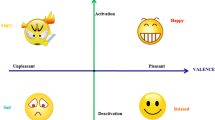Abstract
At present, social communication occupies an increasingly important position in people’s lives. It is especially important to correctly identify other people’s emotional information in social communication. Therefore, emotion recognition is also a hot issue in intelligent information processing. This paper focuses on this problem, mainly based on the feature selection method in emotional recognition of EEG signals. How to select emotion-related features in high-dimensional features is a key factor to achieve fast, accurate and effective identification. This paper proposes a feature selection method based on sparse learning. The method can find a small number of features that contribute to the reconstruction of the category information from the high-dimensional feature space, so as to achieve the purpose of quickly and efficiently acquiring small and emotionally related features. The experimental results show that compared with the traditional method, the proposed method reduces the time consumption of feature selection and obtains a higher emotional five-category correct rate under the same feature dimension.



Similar content being viewed by others
References
Jenke, R., Peer, A., Buss, M.: Feature extraction and selection for emotion recognition from EEG. IEEE Trans. Affect. Comput. 3, 327–339 (2014)
Wang, X.W., Nie, D., Lu, B.L.: Emotional state classification from EEG data using machine learning approach. Neurocomputing 129, 94–106 (2014)
Rozgic, V., Vitaladevuni, S.N., Prasad, R.: Robust EEG emotion classification using segment level decision fusion. In: IEEE International Conference on Acoustics, Speech and Signal Processing (ICASSP), pp. 1286–1290. IEEE (2013)
Wang, X.W., Nie, D., Lu, B.L.: EEG-based emotion recognition using frequency domain features and support vector machines. In: Neural Information Processing, pp. 734–743. Springer, Berling (2011)
Nie, D., Wang, X.W., Shi, L.C., et al.: EEG-based emotion recognition during watching movies. In: 2011 5th International IEEE/EMBS Conference on Neural Engineering (NER), pp. 667–670. IEEE (2011)
Reuderink, B., Müh, C., Poel, M.: Valence, arousal and dominance in the EEG during game play. Int. J. Auton. Adapt. Commun. Syst. 6(1), 45–62 (2013)
Schaaff, K., Schultz, T.: Towards emotion recognition from electroencephalographic signals. In: 3rd International Conference on Affective Computing and Intelligent Interaction and Workshops. ACII 2009, pp. 1–6. IEEE (2009)
Hadjidimitriou, S.K., Hadjileontiadis, L.J.: Toward an EEG-based recognition of music liking using time-frequency analysis. IEEE Trans. Biomed. Eng. 59(12), 3498–3510 (2012)
Brown, L., Grundlehner, B., Penders, J.: Towards wireless emotional valence detection from EEG. In: 2011 Annual International Conference of the IEEE Engineering in Medicine and Biology Society, EMBC, pp. 2188–2191. IEEE (2011)
Hall, M.A.: Correlation-based feature selection for machine learning. The University of Waikato (1999)
Lin, Y.P., Wang, C.H., Jung, T.P., et al.: EEG-based emotion recognition in music listening. IEEE Trans. Biomed. Eng. 57(7), 1798–1806 (2010)
Somol, P., Novovicová, J., Pudil, P.: Efficient Feature Subset Selection and Subset Size Optimization. INTECH Open Access Publisher (2010)
Saeys, Y., Inza, I., Larrañaga, P.: A review of feature selection techniques in bioinformatics. Bioinformatics 23(19), 2507–2517 (2007)
Liu, H., Motoda, H.: Computational Methods of Feature Selection. CRC Press, Boca Raton (2007)
Xu, L., Yan, P., Chang, T.: Best first strategy for feature selection. In: 9th International Conference on Pattern Recognition, 1988, pp. 706–708. IEEE (1988)
Lu, B., Hui, M., Yu-Xia, H.: The development of native chinese affective picture system—a pretest in 46 college students. Chin. Ment. Health J. 19(11), 719–722 (2005)
Robnik-Šikonja, M., Kononenko, I.: Theoretical and empirical analysis of Relief F and RRelief F. Mach. Learn. 53(1–2), 23–69 (2003)
Jain, A.K., Duin, R.P.W., Mao, J.: Statistical pattern recognition: a review. IEEE Trans. Pattern Anal. Mach. Intell. 2(1), 4–37 (2002)
Battiti, R.: Using mutual information for selecting features in supervised neural net learning. IEEE Trans. Neural Netw. 5(4), 537–550 (1994)
Zhao, S., Ding, G., Gao, Y., Zhao, X., Tang, Y., Han, J., Yao, H., Huang, Q.: Discrete probability distribution prediction of image, with shared sparse learning. IEEE Trans. Affect. Comput. (2018). https://doi.org/10.1109/TAFFC.2018.2818685
Zhao, S., Yao, H., Gao, Y.: Continuous probability distribution prediction of image emotions via multitask shared sparse regression. IEEE Trans. Multimed. 19(3), 632–645 (2017)
Zhao, Sicheng, Yao, Hongxun, Gao, Yue, Ding, Guiguang, Tat-Seng, Chua: Predicting personalized image emotion perceptions in social networks. IEEE Trans. Affect. Comput. 9(4), 526–540 (2008)
Zhao, Sicheng, Gao, Yue, Ding, Guiguang, Tat-Seng, Chua: Real-time multimedia social event detection in microblog. IEEE Trans. Cybern 48(11), 3218–3231 (2018)
Zhao, S., Ding, G., Zhao, X., Kurt, K.: EmotionGAN: unsupervised domain adaptation for learning discrete probability distributions of image emotions. In: MM 2018—Proceedings of the 2018 ACM Multimedia Conference, pp. 1319–1327(2018)
Needell, D., Vershynin, R.: Signal recovery from incomplete and inaccurate measurements via regularized orthogonal matching pursuit. IEEE J. Sel. Top. Signal Process. 4(2), 310–316 (2010)
Zhao, S., Ding, G., Huang, Q., Chua T.-S., Schuller Björn, W., Keutzer, K: Affective image content analysis: a comprehensive survey. In: IJCAI International Joint Conference on Artificial Intelligence, pp. 5534–5541 (2018)
Zhao, S., Ding, G., Gao, Y., Han, J.: Approximating discrete probability distribution of image emotions by multi-modal features fusion. In: IJCAI International Joint Conference on Artificial Intelligence, vol. 0, pp. 4669–4675 (2017)
Zhao, S., Yao, H., Gao, Y., Ji, R., Xie, W., Jiang, X., Chua, T.-S.: Predicting personalized emotion perceptions of social images. In: MM 2016—Proceedings of the 2016 ACM Multimedia Conference, pp. 1385–1394 (2016)
Acknowledgements
The author wishes to thank all the colleagues for their efforts and efforts in this trial.
Author contributions
Conceptualization: Yixin Yan. Data curation: Yixin Yan, Chenyang Li. Formal analysis: Yixin Yan, Chenyang, Li. Investigation: Yixin Yan. Methodology: Yixin Yan, Chenyang Li. Validation: Yixin Yan, Chenyang, Li. Writing—original draft: Yixin Yan, Chenyang, Li. Writing—review and editing: Yixin Yan, Chenyang, Li.
Author information
Authors and Affiliations
Corresponding author
Additional information
Publisher’s Note
Springer Nature remains neutral with regard to jurisdictional claims in published maps and institutional affiliations.
Rights and permissions
About this article
Cite this article
Yan, Y., Li, C. & Meng, S. Emotion recognition based on sparse learning feature selection method for social communication. SIViP 13, 1253–1257 (2019). https://doi.org/10.1007/s11760-019-01448-x
Received:
Revised:
Accepted:
Published:
Issue Date:
DOI: https://doi.org/10.1007/s11760-019-01448-x




